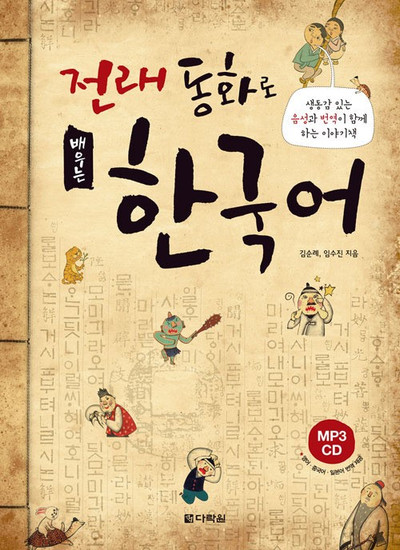 Loading... Please wait...
Loading... Please wait...Change Currency
Categories
- Korean Books
- Bilingual Books (KR-EN)
- Korean Textbooks (국어책)
- Books about Korea
- Cooking Books
- Books written in Korean
- Books for learning Korean(Hangeul)
- Author Han Kang
- Books by language
- Stationery
- Special Order
- Home
- Korean Books
- Books for learning Korean(Hangeul)
- Learning Korean through Traditional Fairy Tales
- Home
- Korean Books
- Books for learning Korean(Hangeul)
- Korean study textbooks
- Learning Korean through Traditional Fairy Tales
- Home
- Korean Books
- Books for learning Korean(Hangeul)
- Korean study textbooks
- Korean culture and others
- Learning Korean through Traditional Fairy Tales
- Home
- Korean Books
- Learning Korean through Traditional Fairy Tales
Learning Korean through Traditional Fairy Tales
Product Description
Learning Korean through Traditional Fairy Tales
Author : Kim, Soonrye Lim, Sujin page : 240 pages Supplement : MP3 CD
ISBN: 9788927730989(8927730984) Size: 182x257 mm
A new reading textbook that includes interesting illustrations and lifelike, original audio recordings and translations!
Learning Korean through Traditional Fairy Tales is a reading textbook for intermediate level students of Korean. It presents Korean proverbs, idiomatic expressions, vocabulary, and grammar in an interesting format, and helps learners improve their listening, reading, writing, and speaking abilities through a variety of activities and lifelike illustrations and audio clips. It helps learners to better understand Koreans and Korean culture. We provide English, Chinese, and Japanese translations for all of the vocabulary, grammar expressions, and main text passages to satisfy the curiosity of learners and allow them to study as correctly and accurately as possible.
A Storybook with Lifelike Audio and Translations
- A new reading textbook that will boost confidence in reading while allowing the reader toimaginethestoriesthroughinterestingillustrations!
Imagining the unfolding plot of each fairy tale with the aid of illustrations, readers will enjoy learning the related vocabulary and expressions, and, then, through acting out the content of the stories, they can increase their confidence in not only reading but speaking as well.
- Learn common Korean idiomatic expressions through traditional fairy tales!
Through traditional fairy tales, readers can learn about Korean culture while also becoming familiar with common Korean idiomatic expressions, such as what it means to be ‘like a tree frog,’ or to ‘act like Nolbu.’
- Improve listening comprehension by leaps and bounds through lifelike audio files!
Readers can also improve their listening comprehension by listening to the included audio files recorded by a veteran professional voice actor.
- Includes a separate appendix with all main text content translated into English, Chinese, and Japanese!
The included appendix with clear English, Chinese, and Japanese translations allows readers to accurately confirm the Korean text content of the fairy tales.
The Characteristics of this Book
This book utilizes the characteristics of traditional fairy tales to allow readers to learn Korean in an interesting and easy manner. For those who are used to reading shorter texts, we have included pre-reading activities to arouse interest in the subject matter. Specifically, illustrations for discussion are provided before entering the main text content. Through such activities, readers can become acquainted with the vocabulary and expressions necessary for reading the main text. Then, after reading the text, post-reading activities are provided for reenacting the storylines through role-play and conversation, and also for acting out different possible endings to the fairy tales. Such activities serve to not only reinforce the joy of reading, but also foster increased confidence in listening and speaking.
Motivates active study of the content by providing illustrations to familiarize readers with the main situations, characters, vocabulary, and expressions related to the fairy tales, and then having them imagine how the story will turn out.
While listening to lifelike audio recordings of the main texts, readers must first take a set of randomly ordered illustrations and put them in the correct chronological order to make a coherent story. Through this process, readers become easily familiarized with new vocabulary and expressions.
Intermediate level readers can directly confirm whether their ideas constructed about the story content during the pre-reading activities when they read the main fairy tale texts.
After reading the main texts and confirming the meaning of the related grammar points and their usage, readers can write their own sentences using the new grammar correctly.
After the illustrations describing the content have been placed in the correct order in accordance with the fairy tale plots, readers can practice summarizing the written Korean content using spoken Korean forms, and then extend the exercise by directly acting out the plot events through role plays.
Readers can actively practice conversation by further modifying and expanding on the content of the traditional fairy tales through cultural comparisons based on their own personal perspectives and experiences.
The inclusion of a variety of interesting content formats, such as proverbs, quizzes, songs, games, and puzzles lets readers feel less intimidated by the main text content of the fairy tales.
To help satisfy the curiosity of wanting to find out the meaning of many of the words and phrases in the main text, we provide a separately bound appendix containing English, Chinese, and Japanese translations for all of the important vocabulary, grammar expressions, and full main texts so that readers can more clearly comprehend what they have read.






